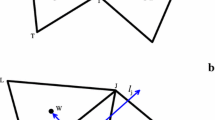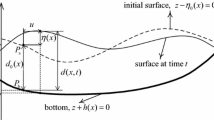Abstract
A Riemann-solver scheme, using primitive variables rather than conserved variables, is configured and tuned for the solution of the fully-coupled two-dimensional shallow water and contaminant transport equations. This scheme is based on the unstructured finite volume discretization using primitive-variable Roe-flux approximation with an entropy fix. The primitive-variable flux associated with the exact source-term balancing is well-behaved and well-balanced for both still-water and dry regions with arbitrary bed topography. Second-order accuracy is used in space and time. The present study uses a nonlinear implicit scheme based on Newton-iterative algorithm for the time integration. In order to show the accuracy of the scheme, numerical results are verified by different test cases for contaminant advection and diffusion. A scenario of contaminant transport in a complex geometry with wet and dry elements is also simulated to demonstrate that the present work can be implemented on practical applications involving flooding and contaminant transport.











Similar content being viewed by others
References
Li S, Duffy CJ (2012) Fully-coupled modeling of shallow water flow and pollutant transport on unstructured grids. Procedia Environ Sci 13:2098–2121
Murillo J, Burguete J, Brufau P, García-Navarro P (2005) Coupling between shallow water and solute flow equations: analysis and management of source terms in 2D. Int J Numer Methods Fluids 49(3):267–299
Murillo J, García-Navarro P, Burguete J, Brufau P (2006) A conservative 2D model of inundation flow with solute transport over dry bed. Int J Numer Methods Fluids 52:1059–1092
Begnudelli L, Sanders BF (2006) Unstructured grid finite-volume algorithm for shallow-water flow and scalar transport with wetting and drying. J Hydraul Eng 132(4):371–384
Benkhaldoun F, Elmahi I, Seaid M (2007) Well-balanced finite volume schemes for pollutant transport on unstructured meshes. J Comput Phys 226(1):180–203
Benkhaldoun F, Elmahi I, Seaid M (2013) An unstructured finite-volume method for coupled models of suspended sediment and bed load transport in shallow-water flows. Int J Numer Methods Fluid 72:967–993
Loukili Y, Soulaimani A (2007) Numerical tracking of shallow water waves by the unstructured finite volume WAF approximation. Int J Comput Methods Eng Sci Mech 8(2):75–88
García-Navarro P, Playán E, Zapata N (2000) Solute transport modelling in overland flow applied to fertigation. J Irrig Drain Eng 126(1):33–40
Wu W, Vieira DA, Wang SS (2004) One-dimensional numerical model for nonuniform sediment transport under unsteady flows in channel networks. J Hydraul Eng 130(9):914–923
Bermudez A, Vázquez-Cendón M (1994) Upwind methods for hyperbolic conservation laws with source terms. Comput Fluids 23(8):1049–1071
Rogers B, Borthwick A, Taylor P (2003) Mathematical balancing of flux gradient and source terms prior to using Roe’s approximate riemann solver. J Comput Phys 192:422–451
Liang Q, Borthwick AG (2009) Adaptive quadtree simulation of shallow flows with wet–dry fronts over complex topography. Comput Fluids 38:221–234
Hou J, Simons F, Mahgoub M, Hinkelmann R (2013) A robust well-balanced model on unstructured grids for shallow water flows with wetting and drying over complex topography. Comput Methods Appl Math Eng 257:126–149
Horváth Z, Waser J, Perdigão R, Konev A, Blöschl G (2015) A two-dimensional numerical scheme of dry/wet fronts for the Saint–Venant system of shallow water equations. Int J Numer Methods Fluid 77:159–182
Guan M, Wright NG, Sleigh PA (2013) A robust 2D shallow water model for solving flow over complex topography using homogenous flux method. Int J Numer Methods Fluid 73:225–249
Sivakumar P, Hyams DG, Taylor LK, Briley WR (2009) A primitive-variable riemann method for solution of the shallow water equations with wetting and drying. J Comput Phys 228(19):7452–7472
Murillo J, García-Navarro P, Burguete J (2008) Analysis of a second-order upwind method for the simulation of solute transport in 2D shallow water flow. Int J Numer Methods Fluids 56:661–686
Behzadi F, Newman JC (2016) A semi-discrete supg method for contaminant transport in shallow water models. Procedia Comput Sci 80:1313–1323
Weiyan T (1992) Shallow water hydrodynamics: mathematical theory and numerical solution for a two-dimensional system of shallow water equations. Elsevier, New York
Hyams DG (2000) An investigation of parallel implicit solution algorithms for incompressible flows on unstructured topologies, Ph.D. Thesis Mississippi State University
Anderson WK, Bonhaus DL (1994) An implicit upwind algorithm for computing turbulent flows on unstructured grids. Comput Fluids 23(1):1–21
Swafford TW (2011) Notes for computational fluid dynamics. SimCenter National Center for Computational Engineering
Whitfield DL, Taylor LK, Discretized Newton-relaxation solution of high resolution flux-difference split schemes, AIAA Paper 91-1539
Taylor L, Whitfield D, Unsteady three-dimensional incompressible Euler and Navier–Stokes solver for stationary and dynamic grids, AIAA Paper 91-1650
Squire W, Trapp G (1998) Using complex variables to estimate derivatives of real functions. SIAM Rev 40:110–112
Whitfield D, Taylor LK (1998) Variants of a two-level method for the approximate numerical solution of field simulation equations, Tech. rep., Computational Fluid Dynamics Laboratory, NSF Engineering Research Center for Computational Field Simulation
Takacs LL (1985) A two-step scheme for the advection equation with minimized dissipation and dispersion errors. Am Meteorol Soc 113:1050–1065
Guo WD, Lai JS, Lin GF, Lee FZ, Tan YC (2011) Finite-volume multi-stage scheme for advection–diffusion modeling in shallow water flows. J Mech 27:415–430
Vanzo D, Siviglia A, Toro EF (2016) Pollutant transport by shallow water equations on unstructured meshes: hyperbolization of the model and numerical solution via a novel flux splitting scheme. J Comput Phys 321:1–20
Kong J, Xin P, Shen CJ, Song ZY, Li L (2013) A high-resolution method for the depth-integrated solute transport equation based on an unstructured mesh. Environ Model Softw 40:109–127
Kawahara M, Umetsu T (1986) Finite element method for moving boundary problems in river flow. Int J Numer Methods Fluids 6:365–386
Acknowledgements
This work was supported by the Tennessee Higher Education Commission Center of Excellence for Applied Computational Science and Engineering. This support is greatly appreciated. The authors sincerely appreciate Dr. Bruce Hilbert and Ethan Hereth for their assistance in generating unstructured grids for the test cases.
Author information
Authors and Affiliations
Corresponding author
Rights and permissions
About this article
Cite this article
Behzadi, F., Shamsaei, B. & Newman, J.C. Solution of fully-coupled shallow water equations and contaminant transport using a primitive-variable Riemann method. Environ Fluid Mech 18, 515–535 (2018). https://doi.org/10.1007/s10652-017-9571-7
Received:
Accepted:
Published:
Issue Date:
DOI: https://doi.org/10.1007/s10652-017-9571-7




